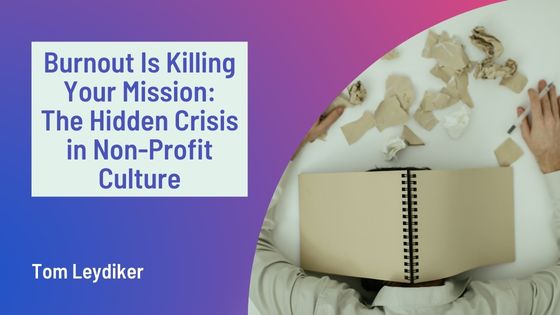The non-profit sector faces a paradoxical crisis: organizations dedicated to healing societal wounds are themselves suffering from a debilitating condition. Staff burnout has reached epidemic proportions, yet remains largely unaddressed in strategic planning and board discussions. This silence doesn’t just hurt employees—it actively undermines the very missions these organizations exist to serve.
The statistics tell a sobering story: non-profit employees experience burnout at rates 20% higher than their corporate counterparts, with program staff and direct service providers suffering the highest rates of all. Turnover in the sector consistently hovers between 19-30% annually, with each departure costing organizations approximately 150% of the departing employee’s salary in recruitment, training, and lost productivity.
Behind these numbers lie real human experiences. Maria, a domestic violence counselor, described reaching a breaking point after three years of carrying an overwhelming caseload: “I started having panic attacks before work. The worst part wasn’t feeling like I was drowning—it was knowing I couldn’t give my clients what they deserved.” After her departure, her organization lost three major relationships with partner agencies that had been built through her personal connection.
The roots of non-profit burnout run deeper than simple overwork, though that’s certainly a factor. The burnout equation typically combines:
- Chronic resource scarcity creating impossible workloads
- Emotional labor required when addressing traumatic social issues
- Mission-driven guilt that discourages self-care and boundary-setting
- Inadequate compensation coupled with high expectations
- Compassion fatigue from continuous exposure to suffering
- Governance structures that prioritize program spending over staff wellbeing
Perhaps most perniciously, the sector has normalized burnout as an expected sacrifice rather than recognizing it as a strategic threat. The martyr mentality—the belief that personal suffering somehow proves dedication to the cause—has become embedded in non-profit culture, despite overwhelming evidence that it ultimately harms both individuals and organizational effectiveness.
Consider the ripple effects when burnout drives talented people from your organization:
- Institutional knowledge and relationship histories disappear
- Remaining staff become further overburdened, accelerating their own burnout
- Program quality suffers as continuity is disrupted
- Fundraising relationships weaken without consistent stewardship
- Community trust erodes with constant staff changes
- Recruitment becomes increasingly difficult as word spreads
The financial cost alone should alarm boards and executive leadership. When factoring in decreased productivity before departure, recruitment expenses, training time, and lost momentum, each instance of burnout-related turnover can cost tens of thousands of dollars—resources that could otherwise advance the mission.
Some forward-thinking organizations have begun addressing burnout as a strategic priority rather than an individual problem. The Mental Health Coalition implemented mandatory paid sabbaticals for staff reaching five-year anniversaries, resulting in a 62% reduction in turnover compared to industry averages. Community Housing Partners instituted meeting-free Fridays and genuine work-from-home policies, leading to improved staff satisfaction scores and decreased sick time usage.
Addressing burnout requires systemic changes:
- Realistic workload planning that accounts for actual capacity, not idealized productivity
- Trauma-informed organizational practices that acknowledge the emotional toll of the work
- Competitive compensation structures that reduce financial stress
- Flexible work arrangements that support work-life integration
- Professional development opportunities that create growth pathways
- Clear boundaries around availability and response expectations
- Leadership that models sustainable work practices
Perhaps most fundamentally, boards and executive leaders must reframe how they view “overhead” spending. Investments in staff wellbeing aren’t distractions from the mission—they’re essential prerequisites for mission success. Organizations cannot deliver their best work through depleted, traumatized teams.
The most effective non-profit leaders are beginning to measure their success not just through programs delivered and dollars raised, but through metrics like staff retention, employee engagement, and sustainable workload distribution. They recognize that their most valuable resource isn’t grant funding or donor relationships—it’s the passionate humans who show up each day to do the work.
If your organization is serious about creating lasting change, addressing burnout isn’t optional—it’s imperative. The mission you save may be your own.







